| Swedish Royalty |
| House of Eric |
|---|
 |
| Eric IX |
|
| Canute I |
|
| Eric X |
|
| Eric XI |
Catherine (Swedish : Katarina Eriksdotter; 12th-century) was a Swedish princess, daughter of King Eric the Saint and his queen, Christina of Sweden.
| Swedish Royalty |
| House of Eric |
|---|
 |
| Eric IX |
|
| Canute I |
|
| Eric X |
|
| Eric XI |
Catherine (Swedish : Katarina Eriksdotter; 12th-century) was a Swedish princess, daughter of King Eric the Saint and his queen, Christina of Sweden.
She married Nils Blake, who probably was a Swedish magnate. They had a daughter, Kristina Nilsdotter, who married the Norwegian Earl Hakon the Mad, and later Eskil Magnusson, the lawspeaker of Västergötland.

Gustav IV Adolf or Gustav IV Adolph was King of Sweden from 1792 until he was deposed in a coup in 1809. He was also the last Swedish monarch to be the ruler of Finland.

John III was King of Sweden from 1569 until his death. He was the son of King Gustav I of Sweden and his second wife Margaret Leijonhufvud. He was also, quite autonomously, the Duke of Finland from 1556 to 1563. In 1581 he assumed the title Grand Prince of Finland. He attained the Swedish throne after a rebellion against his half-brother Eric XIV. He is mainly remembered for his attempts to close the gap between the newly established Lutheran Church of Sweden and the Catholic Church, as well as his conflict with and murder of his brother.

Karl Knutsson, also known as Charles VIII and called Charles I in Norwegian contexts, was King of Sweden and King of Norway (1449–1450).
An heir apparent or simply heir is a person who is first in an order of succession and cannot be displaced from inheriting by the birth of another person. A person who is first in the current order of succession but could be displaced by the birth of a more eligible heir is known as heir presumptive.

Olof Skötkonung, sometimes stylized as Olaf the Swede, was King of Sweden, son of Eric the Victorious and, according to Icelandic sources, Sigrid the Haughty. He succeeded his father in c. 995. He stands at the threshold of recorded history, since he is the first Swedish ruler about whom there is substantial knowledge. He is regarded as the first king known to have ruled both the Swedes and the Geats. In Sweden, the reign of king Olov Skötkonung is considered to be the transition from the Viking age to the Middle Ages, he was the first Christian king of the Swedes, who ruled central Sweden. Norse beliefs persisted in parts of Sweden until the 12–13th century.
Richeza of Poland, a member of the House of Piast, was twice Queen of Sweden and once Princess of Minsk through her three marriages.
The Bush family is an American political family that has played a prominent role in American politics since the 1950s, foremost as the first family of the United States from 1989 to 1993 and again from 2001 to 2009, during the respective presidencies of George H.W. Bush and George W. Bush. They also played prominent roles in areas of American news, sports, entertainment, and business. They were also the second family of the United States from 1981 to 1989, when George H. W. Bush was vice president. The Bush family is one of four families to have produced two presidents of the United States by the same surname; the others were the Adams, Roosevelt, and Harrison families.

Laurentius PetriNericius was a Swedish clergyman and the first Evangelical Lutheran Archbishop of Sweden. He and his brother Olaus Petri are, together with the King Gustav Vasa, regarded as the main Lutheran reformers of Sweden. They are commemorated by the Evangelical Lutheran Church in America on 19 April.

The Swedish royal family since 1818 has consisted of members of the Swedish Royal House of Bernadotte, closely related to the King of Sweden. Today those who are recognized by the government are entitled to royal titles and styles, and perform official engagements and ceremonial duties of state. The extended family of the King consists of other close relatives who are not royal and thus do not represent the country officially.

Sigrid the Haughty, also known as Sigrid Storråda (Swedish), is a Scandinavian queen appearing in Norse sagas. Sigrid is named in several late and sometimes contradictory Icelandic sagas composed generations after the events they describe, but there is no reliable historical evidence correlating to her story as they describe her. She is reported by Heimskringla to have been wife of Eric the Victorious of Sweden, sought as wife by Olaf Tryggvasson, then married to Sweyn Forkbeard of Denmark, but elsewhere author Snorri Sturluson says that Sweyn was married to a different woman.
Sverker II or Sverker the Younger was King of Sweden from 1195 or 1196 to 1208 when he was defeated in the Battle of Lena by Prince Eric. Sverker died in the 1210 Battle of Gestilren where his forces battled those of King Eric X.

Carl Johan Arthur, Prince Bernadotte, Count of Wisborg, was the fourth son and fifth and youngest child of King Gustaf VI Adolf of Sweden and his first wife, Princess Margaret of Connaught.

The House of Stenkil was a dynasty on the Swedish throne from c. 1060 to c. 1125. Stenkil probably originated from Västergötland.

Dietrich or Theoderic of Oldenburg was a feudal lord in Northern Germany, holding the counties of Delmenhorst and Oldenburg. He was called "Fortunatus", as he was able to secure Delmenhorst for his branch of the Oldenburgs.
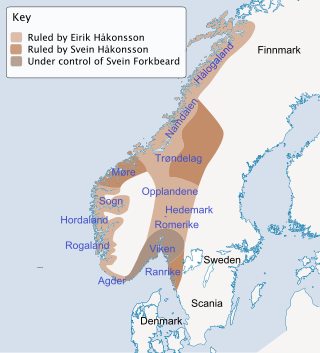
Sweyn Haakonsson was an earl of the house of Hlaðir and co-ruler of Norway from 1000 to c. 1015. He was the son of earl Hákon Sigurðarson. He is first mentioned in connection with the battle of Hjörungavágr, where the Heimskringla says he commanded 60 ships. After the battle of Svolder in the year 1000, Sveinn became co-ruler of Norway with his half-brother, Eiríkr Hákonarson. After Eiríkr went to England in 1014, Sveinn was co-ruler with Hákon Eiríksson. In 1015, Óláfr Haraldsson arrived in Norway and claimed the throne. He defeated Sveinn and his allies in the battle of Nesjar. Sveinn retreated to Sweden, intending to muster a force to retake Norway but he died of an illness before he could return.
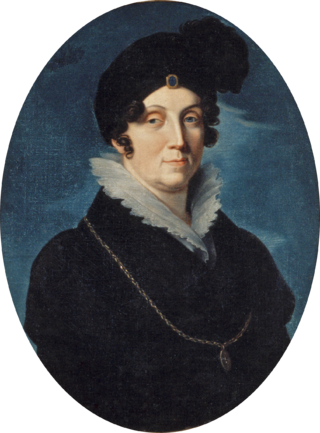
Princess Amalie of Hesse-Darmstadt was a Hereditary Princess of Baden by marriage to Charles Louis, Hereditary Prince of Baden. She was the daughter of Ludwig IX, Landgrave of Hesse-Darmstadt and Henriette Karoline of Palatine-Zweibrücken.
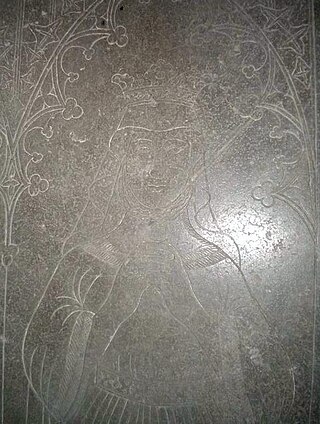
Richeza of Denmark was Queen of Sweden as the wife of King Eric X, and the mother of King Eric XI.
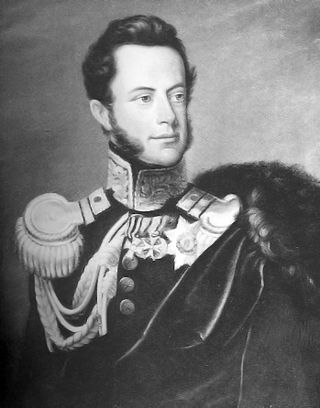
Wilhelm was joint sovereign Duke of Nassau, along with his father's cousin Frederick Augustus, reigning from 1816 until 1839. He was also sovereign Prince of Nassau-Weilburg from 1816 until its incorporation into the duchy of Nassau.
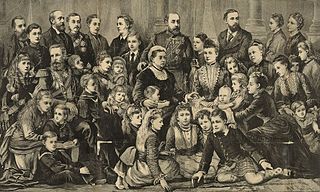
Queen Victoria, the British monarch from 1837 to 1901, and Prince Albert had 9 children, 42 grandchildren, and 87 great-grandchildren. Victoria was called the "grandmother of Europe".

The House of Estridsen was a dynasty that provided the kings of Denmark from 1047 to 1412. The dynasty is named after its ancestor Estrid Svendsdatter. The dynasty is sometimes called the Ulfinger, after Estrid's husband, Ulf Jarl. The dynasty also provided three medieval rulers of Sweden and one of Norway. Their family coat of arms became the coat of arms of Denmark and thereby influenced the coat of arms of Tallinn and the coat of arms of Estonia.
![]() This article contains content from the Owl Edition of Nordisk familjebok, a Swedish encyclopedia published between 1904 and 1926, now in the public domain.
This article contains content from the Owl Edition of Nordisk familjebok, a Swedish encyclopedia published between 1904 and 1926, now in the public domain.